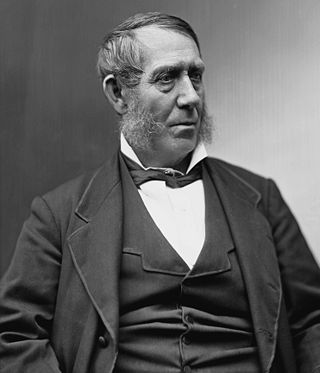
Samuel Jones Tilden was an American politician who served as the 25th governor of New York and was the Democratic nominee in the disputed 1876 United States presidential election.

The Republican Party of Iowa (RPI) is the affiliate of the United States Republican Party in Iowa. The State Central Committee is chaired by Jeff Kaufmann. The RPI operates the Republican side of the Iowa caucuses and previously sponsored the Iowa Straw Poll.

Shepherd Leffler was one of the two original U.S. Representatives to represent Iowa when the state was first admitted to the Union. Elected as a Democrat in 1846, Leffler went on to represent Iowa's 2nd congressional district in the U.S. House for additional terms.

The 1875 United States Senate election in New York was held on January 19 and 20, 1875, by the New York State Legislature. The legislature, with a Republican Senate and Democratic Assembly, jointly elected Democrat Francis Kernan Senator. Kernan became the first Democrat to represent New York since 1851.

The 1874–75 United States Senate elections were held on various dates in various states. As these U.S. Senate elections were prior to the ratification of the Seventeenth Amendment in 1913, senators were chosen by state legislatures. Senators were elected over a wide range of time throughout 1874 and 1875, and a seat may have been filled months late or remained vacant due to legislative deadlock. In these elections, terms were up for the senators in Class 1.

The 1970 Pennsylvania gubernatorial election was held on November 3. Democrat Milton Shapp challenged incumbent Republican Lieutenant Governor Ray Broderick.

The 1916 United States presidential election in New York took place on November 7, 1916. All contemporary 48 states were part of the 1916 United States presidential election. Voters chose 45 electors to the Electoral College, which selected the president and vice president.

The 1904 South Dakota gubernatorial election was held on November 8, 1904. Incumbent Republican Governor Charles N. Herreid declined to run for re-election to a third term. Clark County State's Attorney Samuel H. Elrod won the Republican nomination to run as Herreid's successor, and he faced Democratic nominee Louis N. Crill, the former president of the state Senate, and former U.S. Congressman Freeman Knowles, the Socialist nominee. For the first time since 1894, the Democratic and Populist Parties nominated separate candidates. Ultimately, the split in the two parties did not prove dispositive; Elrod defeated Crill and the other candidates in a landslide.

The 1876 United States presidential election in Connecticut took place on November 7, 1876, as part of the 1876 United States presidential election. Voters chose six representatives, or electors to the Electoral College, who voted for president and vice president.

The 1926 Massachusetts gubernatorial election was held on November 2, 1926.

The 1876 Colorado gubernatorial election took place on October 3, 1876, to elect the 1st Governor of Colorado after the state was admitted to the union on August 1, 1876. Republican John Long Routt, last governor of the Colorado Territory, was elected in a close race against Democratic nominee Bela M. Hughes.

The 1912 Rhode Island gubernatorial election was held on November 5, 1912. Incumbent Republican Aram J. Pothier defeated Democratic nominee Theodore F. Green with 43.67% of the vote.

The 1912 Indiana gubernatorial election was held on November 5, 1912. Democratic nominee Samuel M. Ralston defeated Progressive nominee Albert J. Beveridge and Republican nominee Winfield T. Durbin with 42.95% of the vote. The vote splitting between the Republican and Progressive nominees benefited Democrat Ralston tremendously in this election.

The 1875 Connecticut gubernatorial election was held on April 5, 1875. Incumbent governor and Democratic nominee Charles R. Ingersoll defeated Republican nominee J. Greene with 53.23% of the vote.

The 1857 Connecticut gubernatorial election was held on April 6, 1857. Former Lieutenant Governor and Republican nominee Alexander H. Holley defeated former congressman and Democratic nominee Samuel Ingham with 50.44% of the vote.

The 1856 Connecticut gubernatorial election was held on April 7, 1856. Incumbent governor and American Party nominee William T. Minor defeated former congressman and Democratic nominee Samuel Ingham and former Comptroller of Connecticut and Republican nominee Gideon Welles with 38.99% of the vote.

The 1888 Tennessee gubernatorial election was held on November 6, 1888. Incumbent Democratic governor Robert Love Taylor defeated Republican nominee Samuel W. Hawkins with 51.78% of the vote.

The 1928 Missouri lieutenant gubernatorial election was held on November 6, 1928. Republican nominee Edward Henry Winter defeated Democratic nominee Frank Gaines Harris with 52.47% of the vote.

The 1859 Iowa gubernatorial election was held on 11 October 1859 in order to elect the Governor of Iowa. Republican nominee and incumbent Iowa Senate member Samuel J. Kirkwood defeated Democratic nominee and former United States Ambassador to Spain Augustus C. Dodge.

The 1861 Iowa gubernatorial election was held on 8 October 1861 in order to elect the governor of Iowa. Incumbent Republican governor Samuel J. Kirkwood was re-elected against Democratic nominee William H. Merritt and several other candidates.





















